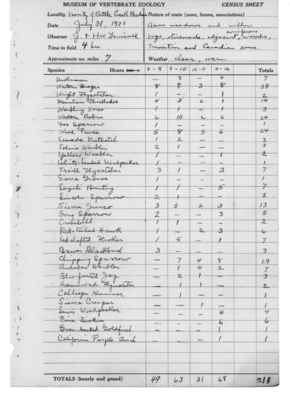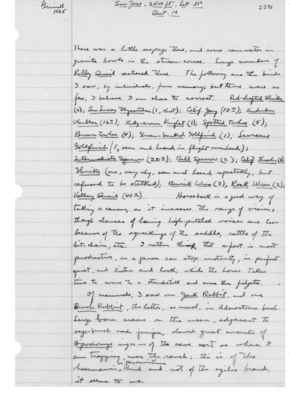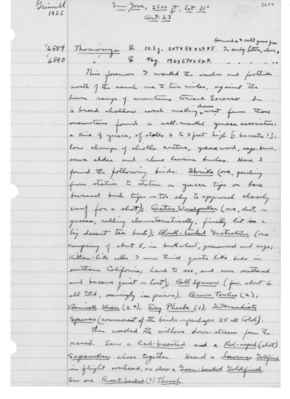Pages That Mention Green-backed Goldfinch
1925: Joseph Grinnell's field notes
S2 Page 4
Collector: Grinnell - 1925 Location: Lassen Section Date: June 12, 1925 Page Number: 2460
slopes of Inskip Hill); Calif. Woodpecker; Nuttall Woodpecker; Calif. Purple Finch (very common and in full song here in the black oaks); Linnet (equally common and in full song); Western Tanager (one in full song, as I write); Cassins Vireo and Western Warbling Vireo (equally in evidence); Wood Pewee (common); Ash-Throated Flycatcher ( "buckaroo" song heard early in the morning from slopes of Inskip Hill; Black-Throated Gray Warbler (several singing males); Lutescent Warbler (one singing male) Western Lark Sparrow (several); Western Chipping sparrow (common and singing); Green-backed Goldfinch (singing birds almost continually within hearing); Wren-tit (heard song from bushy slopes of Inskip Hill; Valley Quail (sentinel call of male in distance); Plain Tit (one pair, in black oaks); Slender-billed Nuthatch (very common); Bullock Oriole (one heard); Morning Dove (several have flown past); The "stream" right here is now dry - all the water taken out for the ranches around Payne Creek P.O. But down below here a few rods a narrow canyon begins, cut down thru the lava cap, and there, there are potholes with water, the source, apparently, for the birds of these woods. Along the ravine are luxurious golden oaks, densely blooming syringia (Philadelphus), ash trees, etc. Up in the rocky walls are bushes of Cercis and Rhus Trilobata.
S2 Page 86
| MUSEUM OF VERTEBRATE ZOOLOGY | CENSUS SHEET |
| Locality: Vicinity of Battle Creek Meadows | Nature of Route(zone,fauna, associations): |
| Date: July 31, 1925 | Across meadows and willow |
| Observer: J. & H.W. Grinnell | bogs, streamside, adjacent ^coniferous woods; |
| Time in Field: 4 hrs. | Transition and Canadian zones |
| Approximate no. miles: 7 | Weather: clear, warm |
| Species Hours[arrow symbol pointing right] | 8-9 | 9-10 | 10-11 | 11-12 | Totals | |
| Unknown | - | 3 | - | 4 | 7 | |
| Western Tanager | 8 | 9 | 3 | 8 | 28 | |
| Wright Flycatcher | 1 | - | - | 1 | 2 | |
| Mountain Chickadee | 4 | 3 | 6 | 1 | 14 | |
| Warbling Vireo | 1 | 1 | 0 | 1 | 3 | |
| Western Robin | 6 | 10 | 2 | 6 | 24 | |
| Fox Sparrow | 1 | 0 | 0 | 0 | 1 | |
| Wood Pewee | 5 | 8 | 5 | 6 | 24 | |
| Canada Nuthatch | 1 | 2 | 0 | 0 | 3 |
TOTALS (hourly and grand)|49|63|31|68|211
S3 Page 53
Collector: Grinnell - 1925 Location: San Jose, 2500 ft., Lat. 31 degrees Date: October 19, 1925 Page Number: 2596
There was a little seepage there, and some rainwater in granite bowls in the stream-course. Large numbers of Valley Quail centered there. The following are the birds I saw, by individuals, from memory; but there were so few, I believe I am close & correct. Red-shafted Flicker (2); San Lucas Flycatcher (1, shot); Calif Jay (10±) Audubon Warbler (16±); Ruby-crown Kinglet (1); Spotted Towhee (5); Brown Towhee (4); Green-backed Goldfinch (1); Lawrence Goldfinch (1, seen and heard in flight overhead); Intermediate Sparrow (20±); Bell Sparrow (2); Calif. Thrashers (3); Shrike (one, very shy, seen and heard repeatedly, but refused to be stalked); Bewick Wren (3); Rock Wren (2); Valley Quail (40±). Horseback is a good way of taking a census, as it increases the range of vision, though chances of hearing high-pitched voices are less because of the squeakings of the saddle, rattle of the bit-chain, etc. I rather think that a foot in most productive, as a person can stop instantly, in perfect quiet, and listen and look; while the horse takes time to come to a standstill and even then fidgets. Of mammals, I saw one Jack Rabbit, and one Bush Rabbit, the latter, as usual in Adenostoma bush. Large bare areas in the mesa, adjacent to sage-bush and juniper, showed great amounts of Dipodomys sign — of the same sort as where I am trapping, near the ranch; this is of the heermanni or paramintinus kind and not of the agilis brand, it seems to me.
S3 Page 59
S3 Page 59
Collector: Grinnell - 1925 Location: San Jose, 2500 ft., lat. 31° Date: Oct. 23 Page Number: 2602
6589 Thomomys (female sign) 123g. 207 x 58 x 29 x 5. In sandy bottom, where bermuda & salt grass grow. 6590 “ (female sign) 96g. 190 x 57 x 25 x 4. “ “ “ “ “ “
This forenoon I worked the washes and foothills north of the ranch one to two miles, against the lower range of mountains toward Socorro. In a broad shallow wash down west from those mountains found a well-marked yucca association: a kind of yucca, of stalks 6 to 8 feet high [= buccata?]; low clumps of cholla cactus, greasewood, sage-brush, some alder and rhus laurina bushes. Here I found the following birds: Shrike (one, perching from station to station in yucca tips on bare burned bush tips - too shy to approach closely enuf for a shot); Cactus Woodpecker(one, shot, on yuccas, calling characteristically, finally lit in a big desert tea bush); Black-tailed Gnatcatcher (one company of about 5, in buckwheat, greasewood and sage; kitten-like calls I now think quite like birds in Southern California; hard to see, and soon scattered and became quiet - lost); Ball Sparrow (few, about 6 all told, seemingly in pairs); Brown Towhee (2); Bewick Wren (2+); Say Phoebe (1); Intermediate Sparrow (commonest of the birds - perhaps all 25 told).
Then worked the willows down-stream from the ranch. Saw a Red-breasted and a Red-naped (shot) Sapsucker close together. Heard a Lawrence Goldfinch in flight overhead, as also a Green-backed Goldfinch. Saw one Russet-backed (?) Thrush.



